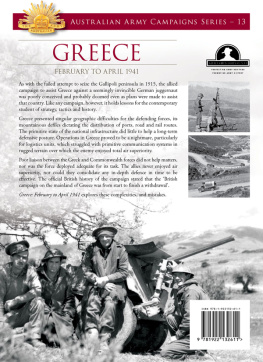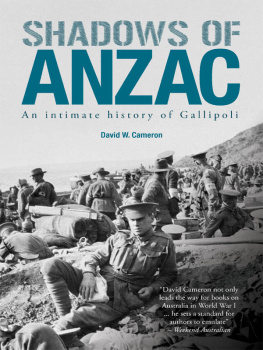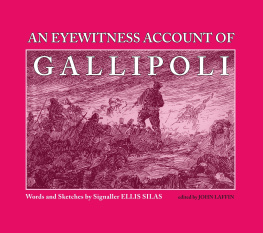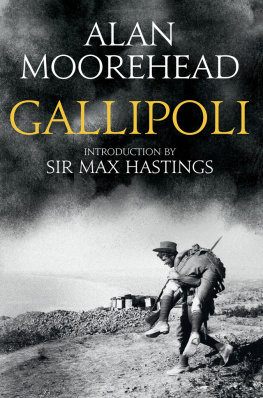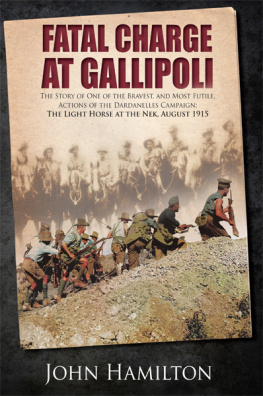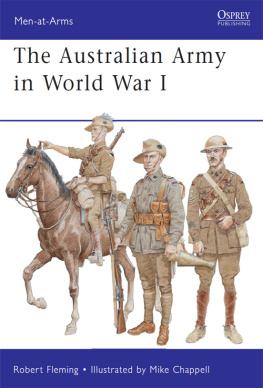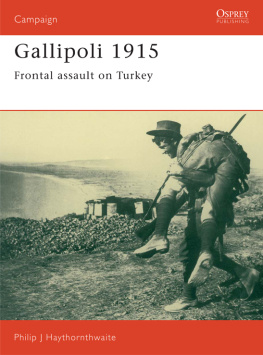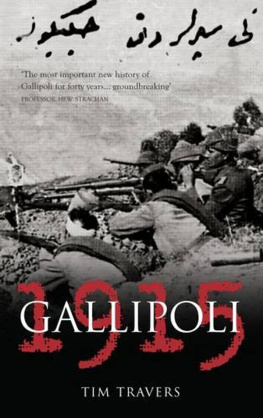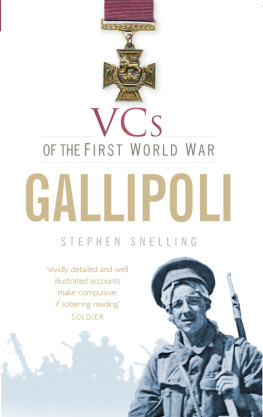
Copyright Army History Unit
Campbell Park Offices (CP2-5-166)
Canberra ACT 2600
AUSTRALIA
(02) 6266 4248
(02) 6266 4044 fax
Copyright 2012 Commonwealth of Australia
First published 2012
This book is copyright. Apart from any fair dealing for the purposes of private study, research, criticism or review as permitted under the Copyright Act, no part may be reproduced, stored in a retrieval system or transmitted in any form or by any means, electronic, mechanical, photocopying, recording or otherwise, without written permission.
All inquiries should be made to the publishers.
Big Sky Publishing Pty Ltd
PO Box 303, Newport, NSW 2106, Australia
Phone: | 1300 364 611 |
Fax: | (61 2) 9918 2396 |
Email: | info@bigskypublishing.com.au |
Web: | www.bigskypublishing.com.au |
National Library of Australia Cataloguing-in-Publication entry (pbk)
Author: Tyquin, Michael B. (Michael Bernard), 1952
Title: Gallipoli: an Australian medical perspective / Michael Tyquin.
ISBN: 9781921941863 (pbk.)
Notes: Includes bibliographical references and index.
Subjects: Australia. Army. Medical Corps--History.
Medicine, Military--Australia--History.
War--Medical aspects.
World War, 1914-1918--Medical care--Australia.
World War, 1914-1918--Campaigns--Turkey--Gallipoli
Peninsula--Participation, Australian.
Dewey Number: 940.5475
National Library of Australia Cataloguing-in-Publication entry (ebook)
Author: Tyquin, Michael B. (Michael Bernard), 1952
Title: Gallipoli [electronic resource]: an Australian medical perspective / Michael Tyquin.
ISBN: 9781921941870 (ebook)
Notes: Includes bibliographical references and index.
Subjects: Australia. Army. Medical Corps--History.
Medicine, Military--Australia--History.
War--Medical aspects.
World War, 1914-1918--Medical care--Australia.
World War, 1914-1918--Campaigns--Turkey--Gallipoli
Peninsula--Participation, Australian.
Dewey Number: 940.5475
Cover design and typesetting by Think Productions, Melbourne
Front cover and title page: View of Rest Gully, showing dugouts on the side of the hill, the 5th Australian Field Ambulance. AWM A01869.
Back cover: Main - 2nd Australian Field Ambulance practising boat drill in the harbour on the Aegean island of Lemnos in preparation for the landing at Anzac Cove. AWM C01632. Top - Stretcher Bearer AWM A01522.
Mid - Red Cross sash AWM REL34450_10001. Bottom - Horse drawn Ambulance AWM J02139.
Contents
Australian Army
Combat Support Series
In 2004 the then Chief of Army Advisory Group, comprising the Armys senior generals, established a scheme to promote the study and understanding of military history in the Army. From this decision the Campaign Series was established, with its focus on Armys future leaders.
The success of the Campaign Series identified the need to document and analyse other aspects of our military history that are not specifically a battle or campaign, or that approaches an element of military service or explores military materiel in support of operations. The Australian Army Combat Support Series was established for this purpose. As with the Campaign Series the Australian Army Combat Support Series will include extensive visual information including specifically prepared maps in colour and 3D, commissioned artwork, photographs and computer graphics.
The Australian Army Combat Support Series complements Armys other history publications, which produce academically rigorous and referenced analytical works. The Australian Army History Unit sees this series growing into another significant contribution to the history of the Australian Army, one that will provide an excellent introduction to Australias Military History.
Roger Lee, Army Historian
Acknowledgments
I would like to thank my long-time colleague and sometime chief Roger Lee, head of the Army History Unit, who is responsible for resurrecting this work in a different guise for a new audience. I remain in debt to the staff at the Australian War Memorial, the National Library of Australia, and the state libraries of Victoria and New South Wales. This book would not have been possible without the assistance of many individuals in various archives in London. These include the National Archives (formerly the Public Records Office, Kew), the Wellcome Institute, the Imperial War Museum, Kings College, and the Caird Library of the National Maritime Museum, Greenwich.
This work has been considerably enhanced by the generously offered skills of John Donovan (editing), Mark Walhert (maps), Jeff Isaacs (illustrations) and suggestions by Glenn Wahlert. I was able also to make use of several photographs courtesy of the Wellcome Trust and the Science Museum in London. Mr. Denny Neave was an understanding publisher bringing this book to print.
Preface
Much of this book is an updating and re-assessment of my 1993 work, Gallipoli: the Medical War. What follows has been written in a different style for a largely military audience; it takes advantage of more recent scholarship on the campaign, especially from Turkish sources, which contribute to our current understanding of the Gallipoli campaign.
To be successful, a modern army needs logistical support to survive - to arm, feed, transport, and care for its soldiers. The maintenance of health in any army, as history shows us, is a key factor in warfare.
When Australia entered the 1914-1918 War (World War I), the Army Medical Services (AMS) had only recently been brought together after the federation of the Australian colonies in 1901. Like the rest of the 1st Australian Imperial Force (AIF), the AMS was largely an untested organisation of volunteers based on a small cadre of professionals. The prime function of the AMS was to maintain healthy troops at the front or during operations, and to return the sick and injured to duty as soon as possible.
In many respects the Gallipoli campaign was a doomed undertaking, whose sad end has helped to shape our national identity. The seeds of ultimate defeat in December 1915 were the risks that attended a hugely ambitious, complex, and large-scale amphibious operation - the landings on well-defended shores on the Gallipoli peninsula, under cover of darkness. Communications at the time were primitive, while general staff officers had little understanding of the limitations or needs of the medical organisation, and their own medical assets.
Many Australians are still unaware that the Ottoman forces facing our troops were not only well prepared, but fully expected a landing somewhere along the Gallipoli peninsula. It is no surprise, therefore, that the whole force was very nearly evacuated a few days later.
It is important to remember that this was only one small episode in the much bigger story that was World War I. Gallipolis successes and failures must be considered in that light. Despite the undoubted bravery of the Diggers, they did not fight in a vacuum. Their opponents were the Askers or Mehmetiks (the Turkish equivalent of Diggers) of the Ottoman army.
Our allies, who shared many of the same privations, came from the British, New Zealand, Indian, and French armies. The Australian Army Medical Corps (AAMC) received aid from, and gave support to, all five forces at various times during 1915. This aspect of what we would now recognise as coalition support worked well for most of the campaign.
Next page

